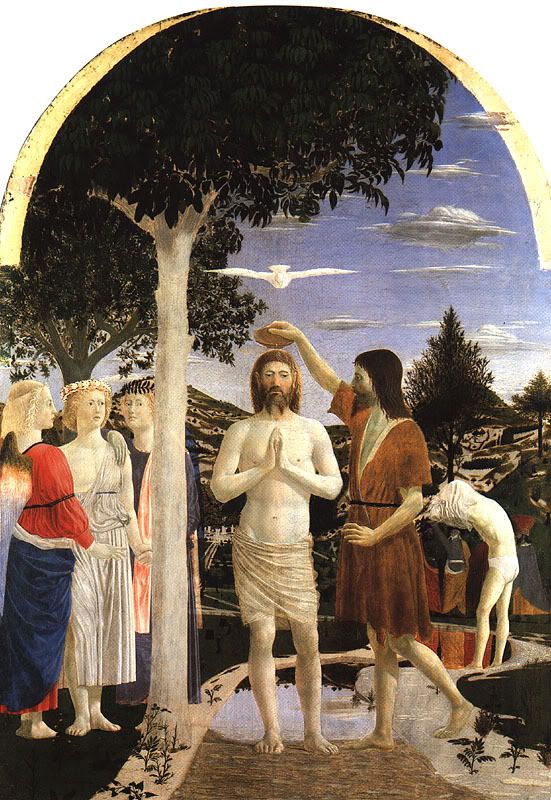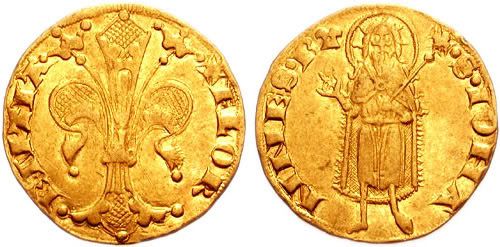Venice was allegorized as Justice (Justitia) and Goddess Rome (Dea Roma) in the 15th century, the latter symbolizing the transfer of imperial power from Rome to Venice. Justice represented the highest value in a state where political power was defined in terms of law. The below picture is representative of the Justice triptych motive found in Venice. (I've processed the picture from its black and white.)
Jutta Gisela Sperling, Convents and the Body Politic in Late Renaissance Venice (Chicago: University of Chicago Press, 2000)
Jacobello del Fiore, Triptych of Justice from the Galleria dell' Academia
Re: The ‘East’: Ferrara, Venice, Alexandria, and Constantinople
12I do not think there is any doubt that the Mediæval European concept of Justice was one that was principally a combination of Judeo-Christian considerations mixed with a descent from the Roman views of Justitia, itself closely tied and descended from the Greek views on Themis and Dike, via, of course, Platonic and Aristotlean thought.
There are sufficient works on seeking to elucidate, for example, Aristotle for this to also be deemed of central relevance in the education of the legal literate.
I look forward to seeing how you make a connection between representations of Michael and Gabriel are pertinent to one or another ordering, and rather puzzled as to how any concept of justice within islam is even pertinent in this context.
There are sufficient works on seeking to elucidate, for example, Aristotle for this to also be deemed of central relevance in the education of the legal literate.
I look forward to seeing how you make a connection between representations of Michael and Gabriel are pertinent to one or another ordering, and rather puzzled as to how any concept of justice within islam is even pertinent in this context.
Re: The ‘East’: Ferrara, Venice, Alexandria, and Constantinople
13Hi, Dai,
mjh
That, even more than the rest of your reply, is sadly revealing.Psykees wrote:I see lots of attacking and inflammatory words in your statements, but little else.
mjh
We are either dwarfs standing on the shoulders of giants, or we are just dwarfs.
Re: The ‘East’: Ferrara, Venice, Alexandria, and Constantinople
14Since Dr. Robert O'Neill has been mentioned several times, I looked around for some of his writings on the Web and discovered his presence on tarot.com. For those interested, here is what he says about Justice:
http://tarot.com/about-tarot/library/boneill/justice
ttfn...
http://tarot.com/about-tarot/library/boneill/justice
ttfn...
Dai Leon
http://www.OriginsOfTheTarot.com
http://www.OriginsOfTheTarot.com
Re: The ‘East’: Ferrara, Venice, Alexandria, and Constantinople
15Though this is perhaps a little removed from the central points, O'Neill's linking of the imagery of the Archangel Michael weighing the souls of the dead with Justitia can indeed account for the 'B' ordering, in that the common image found on Lumiere cathedrals is not only of Christ in Ascension or as King, but also of angels blowing the Trumpet of the last Judgement, as well as, below, on one side the jaws of Hell and on the other the ascent of those destined for heaven around the central figure of Michael and the scales.
This does, indeed, in part account for the transformation or re-understanding of Justice as here more akin to 'Divine Justice' via the actions of Michael... even if the development of Michael with the Scales stems in part from the timing of his day in the first decan of Libra.

This does, indeed, in part account for the transformation or re-understanding of Justice as here more akin to 'Divine Justice' via the actions of Michael... even if the development of Michael with the Scales stems in part from the timing of his day in the first decan of Libra.

Re: The ‘East’: Ferrara, Venice, Alexandria, and Constantinople
16Note the two woman on the left with the angel in this PIERO DELLA FRANCESCA (c. 1420-1492) painting of Baptism of Christ, c. 1450, National Gallery, London:Psykees wrote:One of the most important developments in the religious spheres of the time was the Ecumenical Council of Churches initiated in Venice and held in Ferrara (and subsequently Florence)...

One with a crown of flowers, the other a crown of leaves, reminiscent of the two ladies in the Tarot de Marseille lover card.
Their holding hands is held by some to represent the council of Florence 1439 which sought the Union of the Eastern and Western Churches:
http://en.wikipedia.org/wiki/The_Baptis ... Francesca)
Re: The ‘East’: Ferrara, Venice, Alexandria, and Constantinople
17Of the figure of St. John himself, there is some resemblance in some Tarot de Marseille like world cards that may possibly reflect a distant origin in a figure of St. John?



The world in other decks references the city and possibly a figure of St. John in such context could be taken as emblematic of Florence, of which he was the patron Saint...reflecting perhaps the remnants of a short lived and extinct Florentine pattern... of which elements survived through florentine immigrants to France, returning later to Milan?



The world in other decks references the city and possibly a figure of St. John in such context could be taken as emblematic of Florence, of which he was the patron Saint...reflecting perhaps the remnants of a short lived and extinct Florentine pattern... of which elements survived through florentine immigrants to France, returning later to Milan?
Re: The ‘East’: Ferrara, Venice, Alexandria, and Constantinople
18Apparently, it's been a bit hot in the Study while I was abroad. I've served fresh lemonade, cold cucumber sandwiches, and turned the fans on (you'd think someone would have thought to flip the switch). I've also moved part of this thread on to its own ( viewtopic.php?f=11&t=57 ), and have set this one next to the open window to let a bit of air in.
Ferrara, Venice , Alexandria, and Constantinople... ah, distant and remarkable lands. I remember poor Le Pendu spending many hours looking for Constantinople on a map. I suggested he watch this video for assistance:
http://www.youtube.com/watch?v=xo0X77OBJUg
Ferrara, Venice , Alexandria, and Constantinople... ah, distant and remarkable lands. I remember poor Le Pendu spending many hours looking for Constantinople on a map. I suggested he watch this video for assistance:
http://www.youtube.com/watch?v=xo0X77OBJUg
Re: The ‘East’: Ferrara, Venice, Alexandria, and Constantinople
19That's an incredible image Steve! I'm really struck by the similarity to the caped figure on the World. Fantastic!SteveM wrote:Of the figure of St. John himself, there is some resemblance in some Tarot de Marseille like world cards that may possibly reflect a distant origin in a figure of St. John?
The world in other decks references the city and possibly a figure of St. John in such context could be taken as emblematic of Florence, of which he was the patron Saint...reflecting perhaps the remnants of a short lived and extinct Florentine pattern... of which elements survived through florentine immigrants to France, returning later to Milan?
Re: The ‘East’: Ferrara, Venice, Alexandria, and Constantinople
20http://en.wikipedia.org/wiki/Italian_coin_florin
Also on the popolino:
Italy,Florence, / 1307 to 0 / AR,popolino
dynasty: Florence
person: Republic
obverse type: lis
obverse legend: + FLORENTIA
reverse type: figure of St. John the Baptist stg.
reverse legend: + S IONANNES B
references: CNI.XII.12.50
http://numismatics.org/collection/accnu ... able=false
http://commons.wikimedia.org/wiki/Image:Popolino.jpg
but the silver popolino of Milan apparently had the same design:
http://www.telltale-coins.com/florin/decameron.html
As Huck mention on Aeclectic thread here:
http://www.tarotforum.net/showthread.php?t=91890
And even of other countries, such as England:
http://commons.wikimedia.org/wiki/Image:Florin_1352.jpg
In some countries the figure is sometimes given a different emblem (as axe in Hungary for example) and a differenct Saint name (Ladislaus for example).The name florin refers to the little flower, the lily (also a card motif) on the reverse, from the florence coat of arms.
http://commons.wikimedia.org/wiki/Fiorino
http://commons.wikimedia.org/wiki/Firenze
Also on the popolino:
Italy,Florence, / 1307 to 0 / AR,popolino
dynasty: Florence
person: Republic
obverse type: lis
obverse legend: + FLORENTIA
reverse type: figure of St. John the Baptist stg.
reverse legend: + S IONANNES B
references: CNI.XII.12.50
http://numismatics.org/collection/accnu ... able=false
http://commons.wikimedia.org/wiki/Image:Popolino.jpg
but the silver popolino of Milan apparently had the same design:
http://www.telltale-coins.com/florin/decameron.html
As Huck mention on Aeclectic thread here:
http://www.tarotforum.net/showthread.php?t=91890
And even of other countries, such as England:
http://commons.wikimedia.org/wiki/Image:Florin_1352.jpg
In some countries the figure is sometimes given a different emblem (as axe in Hungary for example) and a differenct Saint name (Ladislaus for example).The name florin refers to the little flower, the lily (also a card motif) on the reverse, from the florence coat of arms.
http://commons.wikimedia.org/wiki/Fiorino
http://commons.wikimedia.org/wiki/Firenze


